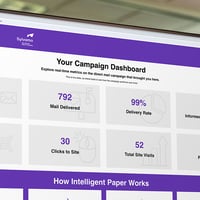5 Benefits of Using Recycled Paper in Commercial Printing
 Ask anyone in the design or print industry about using recycled paper and you’ll likely get some variation on this answer: Printing on recycled paper is good for the environment. And while this is most certainly true, the conversation rarely progresses beyond this point to the variety of specific ways using recycled paper in commercial printing benefits everyone — and everything — involved.
Ask anyone in the design or print industry about using recycled paper and you’ll likely get some variation on this answer: Printing on recycled paper is good for the environment. And while this is most certainly true, the conversation rarely progresses beyond this point to the variety of specific ways using recycled paper in commercial printing benefits everyone — and everything — involved.
Whether you’re looking to reduce your overall carbon footprint or more closely align with the concerns and values of your customers, choosing recycled paper for commercial print projects like direct mail, catalogs, brochures, sales and marketing collateral and more provides a variety of benefits.
Let’s take a quick look at just five of these benefits to help you better understand how and why choosing recycled paper for commercial printing matters.
Recycled paper reduces landfill waste
Did you know the Environmental Protection Agency (EPA) cites landfills as the single largest source of methane emissions into the atmosphere, and that the decomposition of paper as the most significant source of landfill-based methane?
With more than 20 times the heat-trapping ability of CO2, methane is a prime contributor to climate change, and that means taking steps to limit methane emissions is key for the health of the environment.
About 80% of discarded paper winds up in a landfill without ever being recycled, but choosing recycled paper for your print project helps slow the rate at which landfills are filling up, which, in turn, reduces the amount of harmful greenhouse gasses generated by them.
This also emphasizes the importance of recycling used paper and paper products as opposed to simply throwing them away in the nearest garbage can.
Recycled paper has a higher opacity
Compared with virgin paper, recycled paper tends to have a higher opacity, which opens up some interesting cost savings and creative potential. The level of opacity is the ability of paper to hide or mask the colors, text or objects on the other side of the sheet; in other words, the opacity of paper is its ability to block the passage of light from one side to the other, and this ability is important to consider when printing projects like books or pamphlets.
The higher opacity of recycled paper means you can print on more lightweight paper stock without sacrificing quality. The benefits here are two-fold:
- First, the ability to use lighter weight paper stock can help you reduce paper costs
- Second, in the case of direct mail campaigns, a lighter weight stock can also help you save money on postage
Plus, the increased opacity of recycled fibers compared with virgin paper actually makes it a more versatile choice for designers and printers.
Recycled paper helps conserve resources
While you might think the recycling process requires more resources than conventional paper production due to processes like de-inking, shredding and pulping, recycled paper production uses about 26% less energy compared to the production of virgin fiber.
Choosing recycled paper also produces about 40% less wastewater compared with the production of virgin paper, which helps ease the stress on water treatment facilities and reduces the environmental impact of wastewater transportation and disposal.
However, the trade-off is recycled paper can be a bit more expensive than conventional paper, which is why partnering with a supplier that only harvests from sustainably managed forests — which is one that plants new trees to replace the ones that are harvested for paper production — can be a happy medium between controlling costs and making responsible choices for the long-term health of our environment.
Choosing recycled paper better aligns with consumer sentiment and values
A recent article in Forbes indicated that a growing number of consumer demographics put sustainability and environmental responsibility at the top of their priority list when purchasing goods or engaging with brands.
The continued development of a more eco-conscious consumer means using recycled paper for print projects can be a powerful differentiator and strong selling point, and partnering with a paper provider that recognizes and values this shift in consumer sentiment is key in aligning with what consumers want.
Recycled paper reduces forest degradation
Yes, it may seem pretty obvious that using recycled paper in commercial printing helps reduce the number of harvested trees, thus helping to preserve our forests.
But there’s actually more to it than that — a healthy forest system that is not overharvested for paper production means less soil erosion, preserved biodiversity, maintaining wildlife habitats and limiting the amount of greenhouse gasses emitted into the atmosphere during the harvesting process.
Plus, recycled paper made from post-consumer material can be repurposed multiple times, which only increases the environmental value in choosing a recycled fiber and mitigating the impact of forest degradation.
This is also where purchasing paper manufactured from trees that come from a managed forest can help reduce forest degradation, thus helping to maintain a healthy, thriving ecosystem. In addition, working with a paper supplier that provides products from a managed forest also helps provide jobs and stimulates the local economies where these managed forests are located.
Curious how our recycled paper has been used in the past? Take a look at our Accent Portfolio Exchange for some great ideas.





